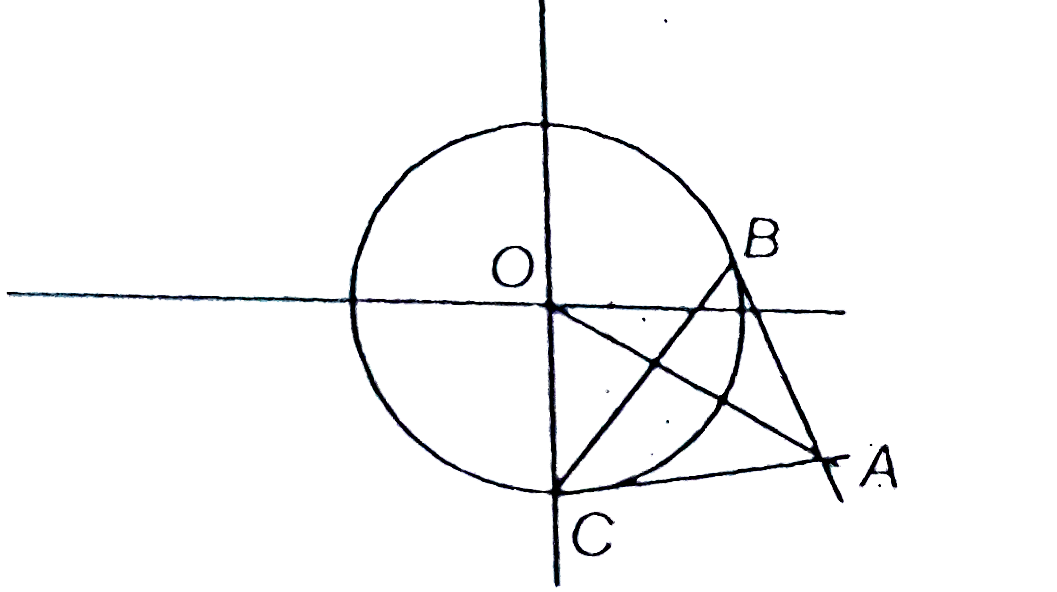From a point on the circle x2+y2=a2 , two tangents are drawn to the circle x2+y2=b2(a>b) . If the chord of contact touches a variable circle passing through origin, show that the locus of the center of the variable circle is always a parabola.
To solve the problem step by step, we will analyze the given conditions and derive the required result.
Step 1: Understand the given circles
We have two circles:
1. The larger circle with the equation x2+y2=a2
2. The smaller circle with the equation x2+y2=b2 where a>b
Step 2: Parametric representation of a point on the larger circle
Let P be a point on the larger circle. We can represent this point in parametric form as:
P(acosθ,asinθ)
Step 3: Equation of the chord of contact
From point P, we can draw two tangents to the smaller circle. The equation of the chord of contact from point P(x1,y1) to the circle x2+y2=b2 is given by:
x1x+y1y=b2
Substituting x1=acosθ and y1=asinθ, we get:
acosθ⋅x+asinθ⋅y=b2
Dividing through by a:
cosθ⋅x+sinθ⋅y=b2a
Step 4: Consider the variable circle passing through the origin
Let the variable circle that passes through the origin have its center at point C(h,k) and radius r. The equation of this circle can be written as:
(x−h)2+(y−k)2=r2
Since the circle passes through the origin, we can substitute (0,0):
h2+k2=r2
Step 5: Tangent condition
For the variable circle to touch the chord of contact, the distance from the center C(h,k) to the line cosθ⋅x+sinθ⋅y=b2a must equal the radius r. The distance d from point (h,k) to the line Ax+By+C=0 is given by:
d=|Ah+Bk+C|√A2+B2
In our case, A=cosθ, B=sinθ, and C=−b2a:
d=|cosθ⋅h+sinθ⋅k−b2a|√cos2θ+sin2θ=|cosθ⋅h+sinθ⋅k−b2a|
Step 6: Set the distance equal to the radius
Setting the distance equal to the radius r:
|cosθ⋅h+sinθ⋅k−b2a|=r
Step 7: Substitute r2=h2+k2
Since r2=h2+k2, we can express this in terms of h and k:
|cosθ⋅h+sinθ⋅k−√h2+k2|=0
Step 8: Locus of the center C(h,k)
The above equation represents a condition that must hold for all θ. By eliminating θ and simplifying, we can show that the locus of the center C(h,k) satisfies the definition of a parabola.
Conclusion
Thus, we conclude that the locus of the center of the variable circle is always a parabola.
---
We have two circles:
1. The larger circle with the equation x2+y2=a2
2. The smaller circle with the equation x2+y2=b2 where a>b
Let P be a point on the larger circle. We can represent this point in parametric form as:
P(acosθ,asinθ)
From point P, we can draw two tangents to the smaller circle. The equation of the chord of contact from point P(x1,y1) to the circle x2+y2=b2 is given by:
x1x+y1y=b2
Substituting x1=acosθ and y1=asinθ, we get:
acosθ⋅x+asinθ⋅y=b2
Dividing through by a:
cosθ⋅x+sinθ⋅y=b2a
Let the variable circle that passes through the origin have its center at point C(h,k) and radius r. The equation of this circle can be written as:
(x−h)2+(y−k)2=r2
Since the circle passes through the origin, we can substitute (0,0):
h2+k2=r2
For the variable circle to touch the chord of contact, the distance from the center C(h,k) to the line cosθ⋅x+sinθ⋅y=b2a must equal the radius r. The distance d from point (h,k) to the line Ax+By+C=0 is given by:
d=|Ah+Bk+C|√A2+B2
In our case, A=cosθ, B=sinθ, and C=−b2a:
d=|cosθ⋅h+sinθ⋅k−b2a|√cos2θ+sin2θ=|cosθ⋅h+sinθ⋅k−b2a|
Setting the distance equal to the radius r:
|cosθ⋅h+sinθ⋅k−b2a|=r
Since r2=h2+k2, we can express this in terms of h and k:
|cosθ⋅h+sinθ⋅k−√h2+k2|=0
The above equation represents a condition that must hold for all θ. By eliminating θ and simplifying, we can show that the locus of the center C(h,k) satisfies the definition of a parabola.
Thus, we conclude that the locus of the center of the variable circle is always a parabola.
Topper's Solved these Questions
- BOOK - CENGAGE ENGLISHCHAPTER - COMPLEX NUMBERS AND QUADRATIC EQUATIONSEXERCISE - All Questions886videos
COMPLEX NUMBERS AND QUADRATIC EQUATIONS
- BOOK - CENGAGE ENGLISHCHAPTER - DIFFERENT PRODUCTS OF VECTORS AND THEIR GEOMETRICAL APPLICATIONS EXERCISE - Multiple correct answers type11videos
DIFFERENT PRODUCTS OF VECTORS AND THEIR GEOMETRICAL APPLICATIONS
Similar Questions
From the variable point A on circle x2+y2=2a2, two tangents are drawn to the circle x2+y2=a2 which meet the curve at BandC. Find the locus of the circumcenter of ABC.
View SolutionFrom a point, perpendicular tangents are drawn to the ellipse x+2y2=2. The chord of contact touches a circle concentric with the given ellipse. The ratio of the maximum and minimum areas of the circle is…
View SolutionFrom a variable point p on line 2x−y−1=0 pair of tangents are drawn to parabola x2=8y then chord of contact passes through a fixed point.
View SolutionIf the intercepts of the variable circle on the x- and y-axis are 2 units and 4 units, respectively, then find the locus of the center of the variable circle.
View SolutionA variable circle passes through the fixed point (2, 0) and touches y-axis Then, the locus of its centre, is
View SolutionA variable circle passes through the fixed point (2, 0) and touches y-axis Then, the locus of its centre, is
View SolutionLet the midpoint of the chord of contact of tangents drawn from A to the circle x2+y2=4 be M(1,−1) and the points of contact be B and C
 View Solution
View SolutionIf the intercepts of the variable circle on the x- and yl-axis are 2 units and 4 units, respectively, then find the locus of the center of the variable circle.
View SolutionTangents AB and AC are drawn to the circlex2+y2−2x+4y+1=0 from A(0,1) then equation of circle passing through A,B and C is
View SolutionA variable chord is drawn through the origin to the circle x2+y2−2ax=0 . Find the locus of the center of the circle drawn on this chord as diameter.
View Solution

